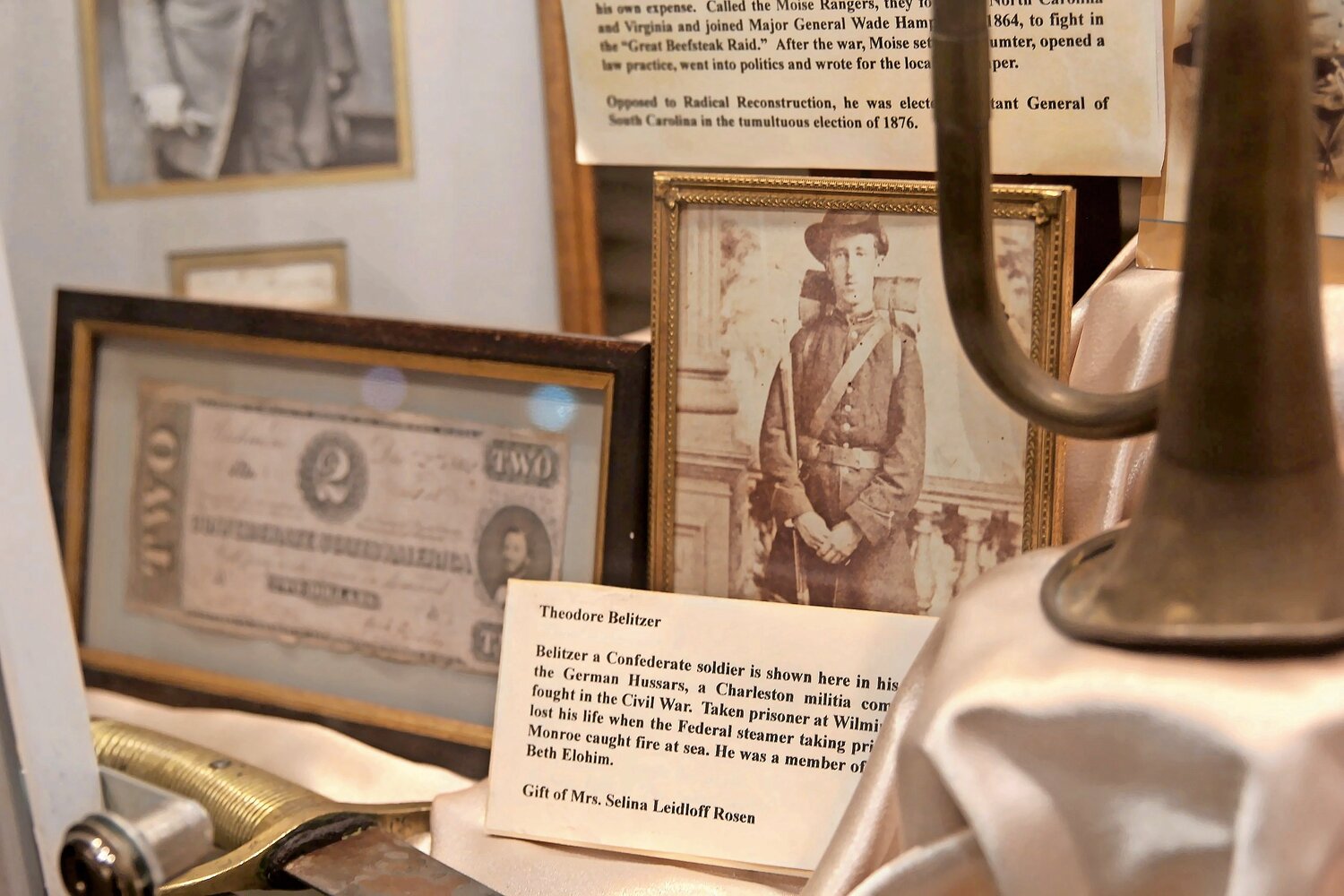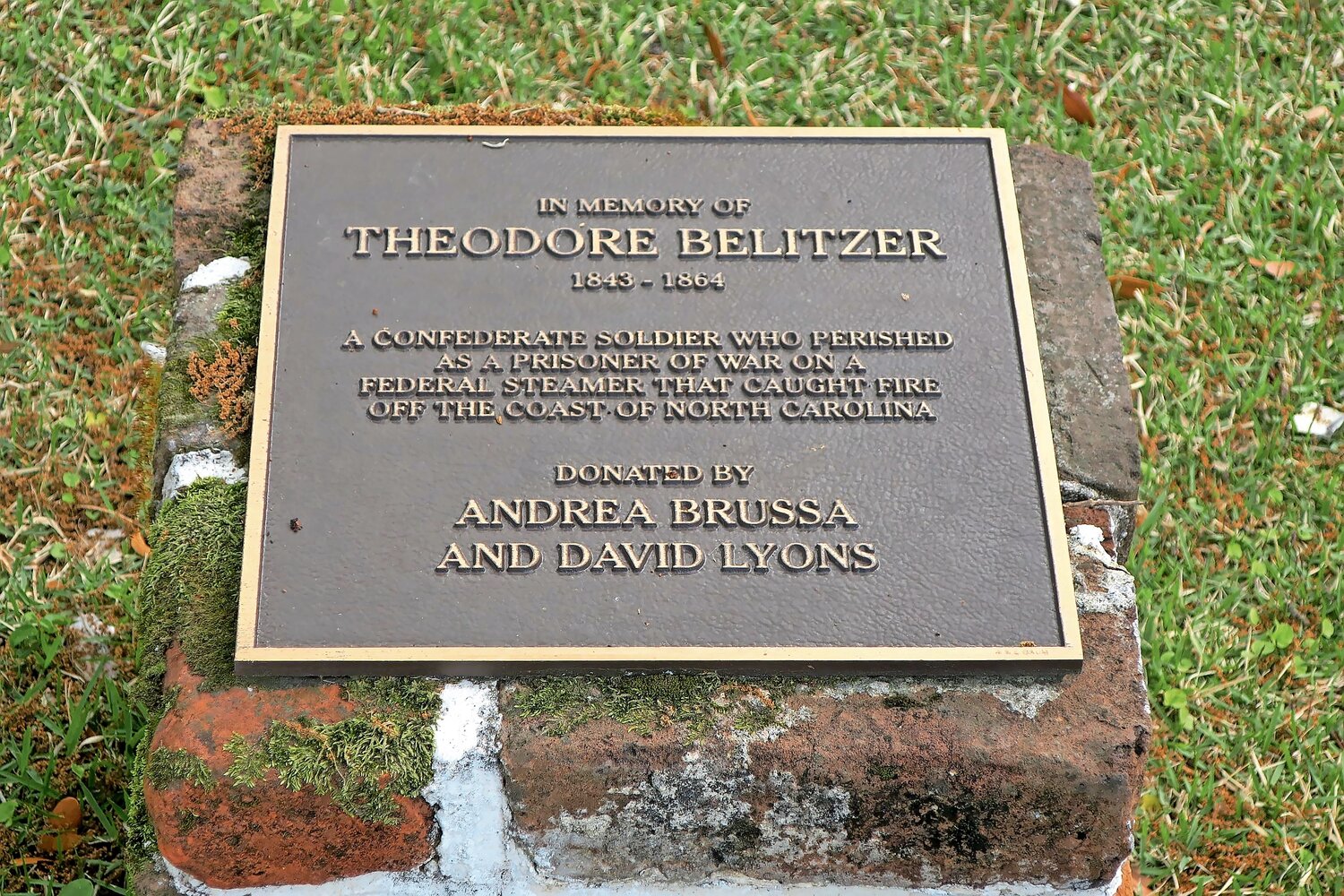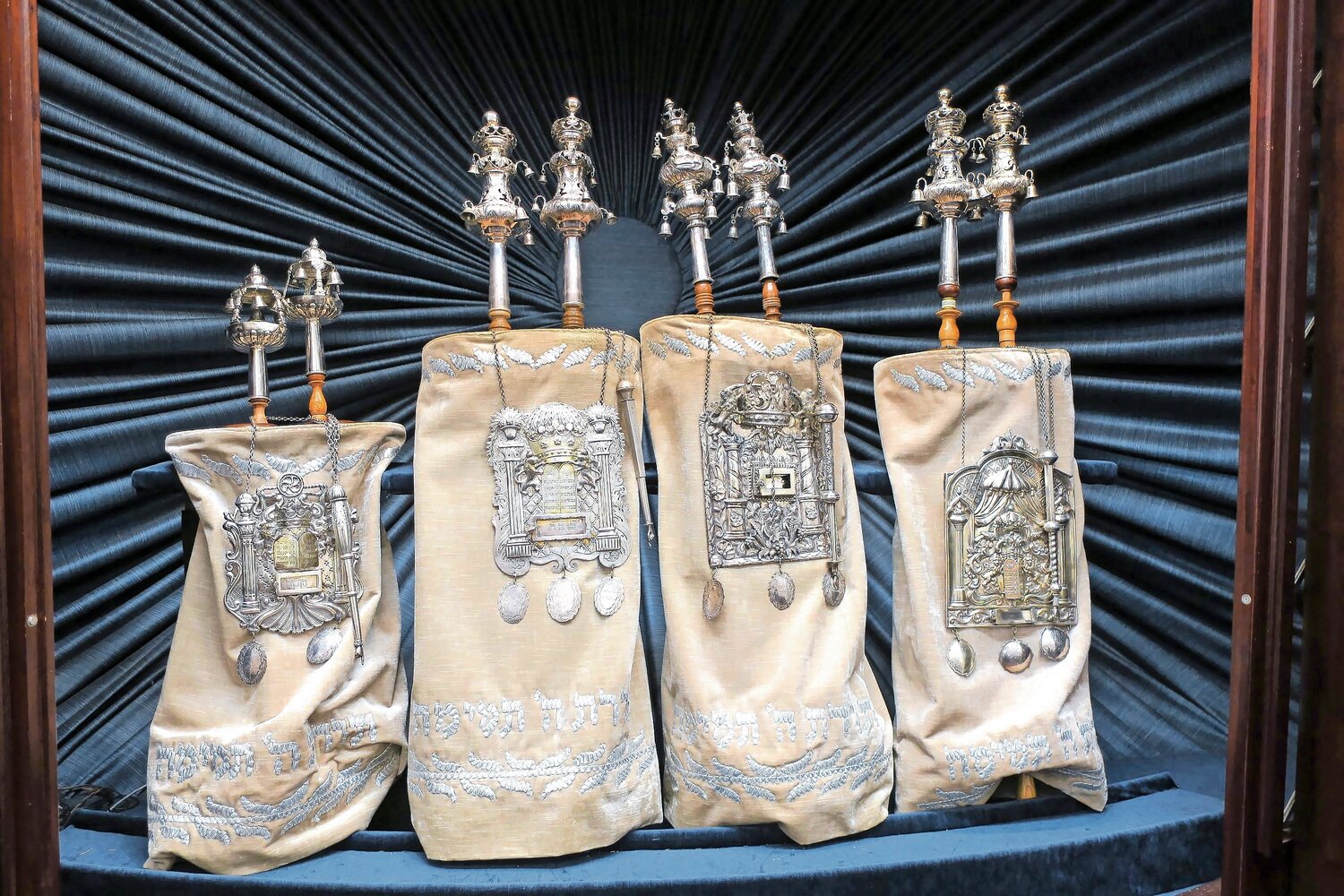After city lived with 275 years of ghosts, Jewish Charleston is bullish on its future
A third of the way into an hour-and-a-half tour of Charleston’s Jewish historic Coming Street Cemetery on an overcast afternoon in April, Anita Rosenberg admits believing in ghosts.
The docent and former president of Kahal Kadosh Beth Elohim (KKBE) — a Reform congregation a mile away that is celebrating its 275th birthday — had directed JNS to stand in a spot along a path lined with decidedly unkosher oyster shells.
“Would you like a ghost story?” the octogenarian asked. JNS affirmed that it did.
About a decade ago, Rosenberg received a call from a man the cemetery hired to cut down a large oak tree threatening a retaining wall. The “young fellow” had quite a view 60 feet up in the air, strapped to the trunk, letting one branch down at a time. He decided to snap a picture.
“My phone rings. He says, ‘Come to the cemetery.’ I said, ‘Why?’ He said, ‘You’ve got a ghost,’” Rosenberg told JNS. “I said, ‘Oh, Charleston is full of ghosts. Don’t worry about it. Just keep cutting.’”
“He said, ‘No. No. I have a picture of your ghost. You have to come,’” Rosenberg said.
Rosenberg showed JNS a blowup of the man’s photo in both positive and negative. An eerie, white shape — reminiscent of a man — appears in the negative.
“I said, ‘Oh. I know exactly who that is — that’s Theodore Belitzer, because we have a real picture of him in the museum’,” Rosenberg said.
The photo that Rosenberg showed JNS of Belitzer, whose family was part of the KKBE congregation and who fought for the South in the Civil War, resembles the negative in the tree man’s picture.
(KKBE boasts of being the oldest synagogue in continuous use in the nation. Touro Synagogue, in Newport, RI, is older but hasn’t been used continuously.)
A Confederate soldier — 23 of whom are buried in the cemetery — Belitzer was taken captive and left on a ship off the North Carolina coast that went up in flames in 1864.
“He never had a proper Jewish burial,” Rosenberg said. “So he’s wandering looking for his place to be, and this was home. This was where his buddies were.”
A colleague of Rosenberg’s, Randy Serrins, was giving a tour of the cemetery to a group of Canadian women in town for Charleston’s annual Spoleto Festival and told Belitzer’s story. “The lady says, ‘Oh, that touches my heart. This young man has got to have a cenotaph of his own,’” Rosenberg said. (Cenotaphs mark bodiless graves.)
“She whipped out her checkbook and gave Randy a check on the spot, right here, and said, ‘Build that boy a cenotaph’,” Rosenberg said. “We did, and we haven’t seen him since,” she said of Belitzer’s ghost.
JNS asked if that meant Rosenberg believed in ghosts. “Oh, yeah,” she said. “Absolutely.”
“We have a lot of ghosts in the family,” her son David Rosenberg, 59, a past president of the Modern Orthodox synagogue Congregation Dor Tikvah in Charleston, told JNS. (Charleston also has a Chabad House.)
“Ghosts are not an extraordinary thing in our world,” added the 10th-generation South Carolinian on his mom’s side.
Anita Rosenberg, who started following her grandmother and the latter’s gardener around the cemetery trimming weeds as a 2-year-old, has her eyes, Janus-like, on both Charleston’s Jewish past and future.
She is “absolutely optimistic” as she considers the next 275 years of Charleston Jewry.
“We’re definitely growing,” she told JNS.
She finds that some young people are interested in Charleston’s Jewish history, and people are retiring to the city and bringing “a whole different perspective” and receptivity to learning about its Jewish past.
“When we say the Jews have been happily ensconced in the Carolina colony from the 1600s, their eyebrows go up, and they say, ‘Tell me more. I never heard of such a thing,’” she said. “The state was a real haven. Religious freedom was guaranteed right here.”
Sitting in the voluminous sanctuary of KKBE across the aisle from Mark Swick, executive director of the congregation, is an exercise in self-restraint to focus on the conversation and not the arresting interior.
Light pours in through colorful stained-glass windows, many with biblical themes. Some depict Noah’s ark, perhaps a nod to the merchants drawn to the city’s ports. An apparent depiction of the burning bush is damaged, a kind-of echo of the 1794 synagogue building’s destruction in an 1838 fire that destroyed many city blocks.
Kahal Kadosh Beth Elohim is both a re-emerged phoenix and a pioneer several times over.
In 1840, KKBE became the first synagogue in the nation to introduce an organ. (The current one on the balcony is its fourth organ.)
“Music within the service, and integration of instrumental music, was one of the requests for reform that our founding congregants and their descendants petitioned the trustees, and were initially unsuccessful,” Swick told JNS.
The reformers broke off and formed the Reform Society of Israelites but rejoined KKBE when the society failed. Years later, traditionalists broke off from the congregation, which is seen as the birthplace of Reform Judaism.
The first Jews arrived in Charleston in the late 17th century — largely Sephardic merchants drawn to the city’s seaport and its unusual hospitality toward Jews, among others. By 1749, KKBE was formed, building its first synagogue 45 years later.
The current Greek Revival building draws on classical Greek architecture while suspending a dome — a distinctly ancient Roman feature — underneath the roof, according to an informational video that plays in the sanctuary for visitors. The elegant ark and interior suggested that Judaism, an older tradition, surpassed the best of Greece and Rome, per the video.
Joshua Lazarus, president of the Charleston Gas Light Company, chaired the KKBE building committee and served as synagogue president from 1850 to 1861. When he introduced gas lighting — literally, not figuratively — to the state, he made sure KKBE got it first.
After the synagogue’s balconies and other parts of the sanctuary were damaged in an August 1886 earthquake, KKBE opted not to rebuild the balconies, as men and women were already sitting together on the main floor. The congregation also added the stained glass windows then, replacing prior clear windows.
In much more recent years, KKBE has been growing, according to Swick, a native of suburban Washington, DC., who has lived in Charleston for a dozen years, after living in Mississippi and Indiana.
“I think people are surprised, in general, that they are welcomed into the Jewish community and that there is a Jewish community,” he said of Charleston, which is increasingly drawing retirees. “The first question is ‘Are there Jews?’ The second question is ‘Is there antisemitism?’ The answer is ‘Yes’ and ‘Not really,’” he said.
Some eight years ago, KKBE had about 430 families that were dues-paying members. Its current membership is about 500 families. “We’ve grown. We’ve also done a better job of being honest about our numbers,” Swick said.
An informal demographic study the Charleston Jewish Federation conducted in 2023 estimated that some 10,000 and 14,000 Jews between the ages of 18 and 80 live in Charleston. In 2016, the Federation estimated that between 8,000 and 11,000 Jews lived in the greater Charleston area, after a 2011 study had estimated about 6,000 Jews.
The religious views of David Lopez, a Jewish builder who designed the current synagogue building, are puzzling, according to Mapping Jewish Charleston, a project of the College of Charleston.
“Initially in favor of an organ in the synagogue, he soon changed his mind, siding with the Orthodox members who left KKBE (ironically, the building he had constructed),” per the site.
“Then there is this: His first wife was not Jewish. When she was not allowed to be buried in the Coming Street Cemetery, he bought a small piece of land where she could be interred adjacent to Shearith Israel’s burial ground, on the northside of KKBE’s cemetery,” it adds.
As Anita Rosenberg told JNS on a tour of the cemetery, the traditional group that split off from KKBE, Shearith Israel, constructed its own plot adjacent to the cemetery with a 12-foot wall separating the two. Much of that wall no longer exists, but visitors can still see traces of that mechitzah-like barrier.
When Lopez’s first wife died, her conversion papers could not be found, according to Rosenberg. When the builder learned that his late wife could not be buried in the Jewish cemetery, he bought an adjacent, rectangular plot and built her the most magnificent grave in the entire cemetery. (It wasn’t clear if the community also rejected her children as Jews at that point.)
When KKBE held a rededication in 2020, it acknowledged that Lopez used slave labor to construct the synagogue. One of the first things that visitors see when they enter the synagogue complex is a plaque noting: “Upon the renovation and rededication of the building in 2020, Kahal Kadosh Beth Elohim rededicates itself to recognizing the errors of the past and reconciling the beliefs of our faith with our actions as we commit to spiritual growth and social justice for all.”
“It’s hard to find many spaces in Charleston that are not impacted by war and past indiscretions,” Swick told JNS. “What we try to do is be honest.” The plaque is upfront about “the original sin of the enslaved labor who helped construct our building,” he said.
Many KKBE members fought for the Confederacy during the Civil War. Tombstones in the cemetery include those of Marx E. Cohen Jr. (1839-1865) and Gustavus Poznanski Jr. (1842-1862), both killed in action during the war. (Officers and soldiers in the American Revolution and the War of 1812 are also buried in the cemetery.)
Ezra Cappell, a professor of Jewish studies and English at the College of Charleston, told JNS that the city, like much of the rest of the country, has been rethinking its history.
“South Carolina hasn’t always been on the forefront of racial understanding, being the last state in the union to remove the Confederate flag from its Capitol grounds,” he said.
Cappell led JNS on a downtown walking tour along King Street of formerly Jewish Charleston — this time architectural ghosts — where he pointed out names inscribed on building façades and on the floor outside shops, which used to be owned by Jews. Some, like Berlin’s and Dumas’s, still are.
At Charleston’s large Holocaust memorial in the city’s Marian Square, Cappell noted that a statue of John C. Calhoun, the former US vice president and a slavery apologist, used to stand nearby until it was removed in response to protests after the murder of George Floyd. The sculpture “literally cast a shadow over Charleston’s Holocaust memorial,” he told JNS.
“So, too, the Jewish community has been conducting a public reckoning of its own past,” Cappell said.
Cappell, who grew up in New York and has lived in Texas, calls Charleston’s Jewish community “warm, welcoming, historic and deeply engaged by all things Jewish.”
“With centuries of history behind it, the Jewish community in Charleston has much to be proud of, and today, the ‘Holy City’ boasts numerous thriving synagogues representing every major Jewish denomination.”
The professor noted that Jews are mentioned specifically in the 1669 Carolina Charter about “liberty of conscience,” and Jews were among the first to settle the region.
“Over the more than three centuries of its existence — from serving in the cause of revolution to holding political office and the creation of the downtown commercial district — the Jewish community has played a vital role in every aspect of Charleston’s growth and development,” he said.
Charleston Jews are uniquely aware and proud of the city’s Jewish history.
“Most New York Jews couldn’t tell you where Shearith Israel is located or where Bob Dylan made his New York debut,” Cappell said. “But Charlestonians will happily tell you about each of the famous Jewish citizens buried in the historic Coming Street Cemetery or regale you with the story of how American Reform Judaism began in 19th-century Charleston.”
The more than 200-year-old Jewish Benevolent Society of Charleston is the oldest Jewish charitable society in the United States, he noted.
“That same animating spirit of tzedakah and helping all those within the community in need of assistance continues to animate so much of Jewish communal life in the city today,” he said. “Clearly, in Charleston, our history is not simply something to be studied about in books, but a living part of our daily life to be examined and experienced as we walk these ancient streets.”
Many Israelis live in Charleston and think of it “with its pristine beaches, inventive culinary scene and laidback seaside vibes as a distinctly American version of Tel Aviv,” he added.
At the College of Charleston, which is home to the Yaschik/Arnold Jewish studies program, there is an “extremely active and supportive” Hillel, according to Cappell. The college has a kosher meal plan for its more than 500 Jewish students, a kosher restaurant (Marty’s Place) and daily minyans near campus, he added.
“At a time when many Jewish college students feel isolated, vulnerable — even under siege — College of Charleston offers Jewish students a warm, safe but intellectually challenging educational experience,” he said.
Swick told JNS that KKBE plans to undertake a strategic plan in the coming years, which will focus in part on climate change and the impact it will have on the synagogue given its geography.
About three-quarters of a mile away, the Charleston Museum, which bills itself as “America’s first museum,” recently celebrated its 250th anniversary. JNS looked closely at every object and every wall text and label in an anniversary exhibit at the museum and saw no mention of anything Jewish, despite the city’s rich Jewish history.
The museum did not contact KKBE to ask to borrow any Jewish objects for its show, Swick told JNS, noting that the synagogue lends its materials out regularly. “It’s a sin of omission,” he thinks.
After JNS left KKBE during one of the visits, a guide rode by in a horse and buggy packed with tourists. The guide pointed towards the synagogue and noted that it was a Jewish house of worship. But no sooner had the horse passed the building that he was already moving on to other topics.
Some Jewish New Yorkers don’t know where Dylan made his debut in the city, some guides rush past one of America’s most storied synagogues and the first US museum might overlook Charleston’s Jewish history.
But even though the Coming Street Cemetery only has five remaining reservations (one person was buried the day before JNS visited), it does its best to accommodate those who are aware of Jewish Charleston history and want to spend a lot longer on-site than the time it takes a horse to walk past.
“If you have a relative, and you come to us and you say, ‘I really want to be buried next to my great-grandfather, we will do our best to find a spot for you’,” Anita Rosenberg told JNS. “And that happens.”











